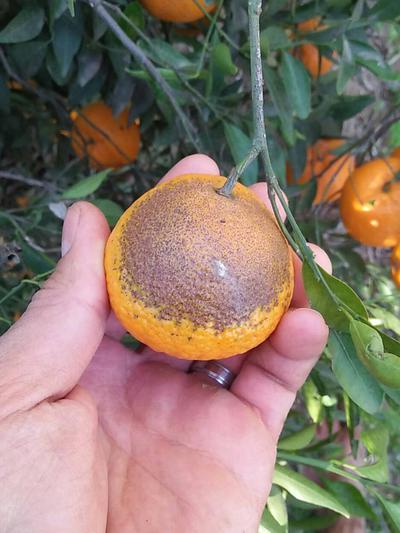Citrus Rust Mite
Phyllocoptruta oleivora
Mite
In a Nutshell
- This pest is known as the Rust Mite on oranges and Silver Mite on lemons.
- They feed on exposed surfaces of fruits that are 1.3cm or larger.
- The fruit skin turns silvery, reddish or black.
- The damage occurs from late spring to late summer.
- As a result, grade and juice quality get reduced in the fresh fruit market.
- In severe cases, the yield is reduced.
Can also be found in
Symptoms
Symptoms vary based on crop variety and fruit maturity. Usually, Citrus Rust Mites are first noticed as bronzing on the skin of mature orange fruits, leaves, and branches. Feeding damage can be observed on green stems, leaves, and fruits. The mites live and inject saliva on both leaf surface and on fruit skin, causing the epidermal skin cells to disintegrate. The upper cuticle looses its glossy nature, and becomes dull and bronze-like or show yellow patches in areas of russeting. Initially, lower leaf surfaces appear as pale patches, and later as necrotic spots. The feeding destroys the rind cells and the surface becomes silvery on lemons, rust brown on mature oranges, and black on green oranges. This is called "russeting" when rust mite injury happened early in the season and "bronzing" when mature fruits are injured. The injured surface is smooth and dark brown in color, and the blemishes become more severe if they hang on the tree longer. Infested fruit appears smaller when injured before fruit maturity. A heavy infestation can cause severe damage in young trees. When Citrus Rust Mite feeds on fruit during the early spring season, the peel turns rough in texture with a lighter color than during summer. This is referred to as sharkskin.
Recommendations

Organic Control
The use of predatory mites such as Euseius citrifolius, Pronematus unbiquitus, and Amblyseius species and parasitic fungus, Hirsutella thompsonii to attack rust mites, helps to keep the population of citrus mites in control. Foliar spray based on oil (3 tablespoons of cooking oil with 4 litres of water and half a tablespoon of detergent soap) or soap solution spray (2 tablespoons of soap/washing liquid with 4 litres of water) can reduce the mite infestation. Don't apply oil spray when temperatures exceed 35°C. Spray the underside of leaves and re-spray after 3 to 4 weeks if necessary.

Chemical Control
Always consider an integrated approach with preventive measures and biological treatments, if available. Take action when more than 30% of trees are infested. Choose your chemical treatment carefully as it might also affect beneficial insects. All miticides should be used only once a year to minimize resistance development. Pesticides such as Spirodiclofen, Diflubenzuron, Abamectin, Acequinocyl, Spirotetramat, micronized or wettable Sulphur, Fenpyroximate, and Chlorpyrifos can be used to eliminate the mite community.
What caused it?
Damage is caused by the feeding activities of adult Rust Mite. It is characterized as microscopic in nature and barely visible to the naked eye. It is obvious only when present in large numbers on the fruit or leaf surface. It gives the appearance of powder dust. White, spherical eggs are laid in small groups on the surface of the leaves or fruits. The egg is then followed by two active nymph stages before turning into an adult mite. One generation of mites can be completed in six days at 30°C. Females live for four to six weeks laying 30 eggs in a lifetime. The frequent presence of isolated blemished fruit is the first sign of Rust Mite infestation in an orchard. When this is noted during a particular season, it must be regarded as a serious Rust Mite warning for the following season. This pest prefers humid conditions and is very common during tropical and subtropical climates. Mites can spread from tree to tree by the wind.
Preventive Measures
- Select tolerant varieties, if available.
- Monitor the orchard with a hand lens for infestation symptoms.
- Maintain suitable conditions for predatory species such as other insects and birds.
- Maintain good air circulation by pruning within the trees.
- Control weed population within the orchard by uprooting them.



